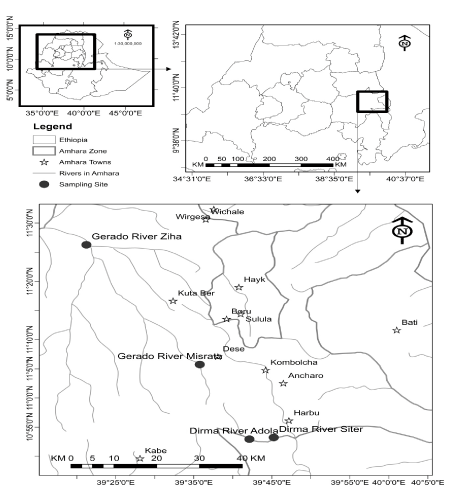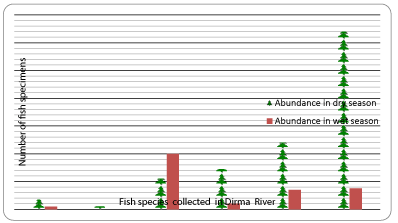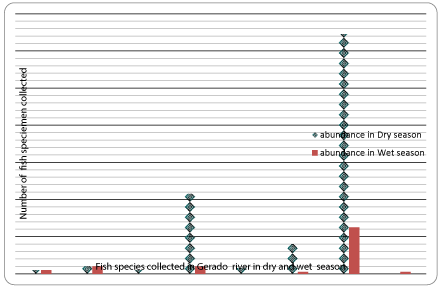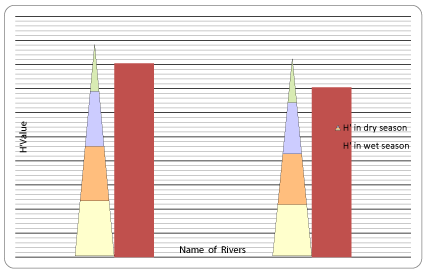Keywords
Abundance; Season; Shannon Index; Species Composition
Introduction
Fishes are the important elements in the economy of many nations as they have been a stable item in the diet of many people. According to Ehrlich and Willson (1991) biodiversity is essential for stabilization of ecosystem, protection of overall environmental quality for understanding intrinsic worth of all species on the earth.
Ethiopia is endowed with sizable amount of lotic (running) and lentic (stagnant water) environments whose fishery potential has not yet been fully realized (Brook Lemma, 1987). The inland water body of the county is estimated at about 7,400 km2 of lake area and about 7,000 km total length of rivers (Shibru Tedla, 1973). These water bodies harbor more than a hundred edible fish species, and the annual potential fish yield of the main lakes is roughly between 30,000 and 40,000 metric tons (FAO, 1995).
Although Ethiopia has high production potential and diversity of fish fauna, notable fishery investigation has been carried out only in a few of the numerous freshwater bodies. The territory of Ethiopia seems to be among the regions of African continent which are least explored for their ichthyofauna (Golubtsov et al. 1995). Knowledge on diversity, population structure, distribution, and population of the Ethiopia ichthyofauna has been poorly known; relatively a large number of small, medium and even some large rivers have not been well studied and explored (Abebe Getahun 2005). Therefore, further study on the rivers is vital and a time demanding task. Amhara Region has high fish production potential from major lakes, Lake Tana, Lake Logo, Lake Ardibo and other small water bodies. Moreover, the region has also a considerable fish potential from rivers like, River Shinfa, River Sanja and others ( Dereje Tewabe, 2008). Relatively major rivers in Amhara Region were investigated for their fish diversity.
Freshwater biodiversity has declined faster than either terrestrial or marine biodiversity over the past 30 years (Jenkins, 2003). Biodiversity is often ambiguously misused or overused to describe population dynamics of a location or community (Lawson and Moduke, 2010). Declining river flow rates (discharge) have been a major cause of species loss and are likely to be further reduced by warming temperatures, reduced precipitation and increased water withdrawal for agriculture and other human uses (Plafkin et al., 1989). Future declines can therefore negatively affect freshwater biodiversity. Inland waters and freshwater biodiversity constitute a valuable natural resource, in economic, cultural, aesthetic, scientific and educational terms. The streams and rivers are facing number of environmental problems throughout the world largely associated with anthropogenic activities in their catchment areas (Young et al. 2004). The adverse effects of human activities have resulted in degradation of stream and reverine ecosystem which ultimately alters the structure and function of stream biota. Their conservation and management are critical to the interests of all human, nations and governments. The inland water bodies are reduced in volume and size as the result of human encroachment and climate change in south wollo as the result habitat for ecologically and economically important fish species is under destruction. Gerado and Drima rivers are among the inland water bodies used for irrigation and support crocodile, birds and fishes biodiversity support. Of these organisms fishes are commercially important species that can improve the livelihood of the people around the rivers. However, there is no any information about fishery potential and fish biology of Gerado and Dirma Rivers. Therefore, this study aimed to assess the fish species composition, diversity, fishery potential and to promote discussions for the management of the fishery to avoid risk of fish stock collapse and habitat loss.
Materials and Methods
Study Area
Gerado and Dirma Rivers are found in Abay and Awash basin in South Wollo, Ethiopia respectively. The source of Gerado River is Billen, Dessie and it crosses Tenta and Ambasel districts and join Beshlo River which is one of the significant tributary river of Abbay River . Dirma River originates from high land of Albuko district and crosses Kalu district and Joins Borkena which is one of the significant tributary of Awash River (Figure 1).

Figure 1: Map of the Sampling sites in Gerado and Dirma Rivers (Ziha ,Misrata ,Adola and Sister).
Site Selection and Sampling
In this study, four sampling sites were selected; two from each river (Table 1). Site selection was done by considering nature and velocity of the flowing river, interference by human beings and other farm animals and substrate type of the sediments and accessibility. Each sampling site was sampled twice at dry and twice in wet seasons. Gillnet of stretched mesh size of 6 - 10 cm were used to sample the fish by setting the net at deeper part of the river. Monofilament with meshes size of 20 mm was set on the rivers for one hour to sample small-sized fish species. Then, total length, weight of all specimens of fish was measured to the nearest cm and gm respectively. Picture of fish specimen was taken for each species. After taking the entire necessary information individual specimen was preserved with 4% formalin and was put in plastic jar and was transported to Wollo University, Biology department laboratory for further identification.
| Rivers |
Fishing site |
Location |
Nature of the sites |
| Dirma |
Adola |
1525m |
0579279N |
1202203E |
Irrigation channel |
| Siter |
1478m |
528351N |
1203228 E |
Old irrigation dam |
| Gerado |
Misrata |
2280m |
0564995N |
1223872 E |
Wetland |
| Ziha |
1711m |
538445N |
1264605 E |
In front of Ziha Market |
Table 1: Characteristics of Sampling Sites.
Laboratory Studies
Specimen of fish species were soaked in tap water for one day to wash the formalin and were identified to species level using identification key (Golubtsov et al., 1995).
Species Diversity and Abundance
Estimation of abundance of fish was made by the contribution of the catch in each sampling site using percentage .Shannon diversity index (H′) was used to estimate the diversity of fish.
Shannon Index of Diversity (H′)
The Shannon index of diversity (H′) is a measure of species weighed by the relative abundance (Begon et al., 1990).Shannon index of diversity (H′) was calculated using the formula below
H' =Σ Pi lnpi
Where, pi-the proportion of individuals in the ith species. Shannon index was used to indicate diversity of fishes at different sampling sites or rivers.
Statistical Analysis
Descriptive (Graphs) and Inferential statistics (ANOVA and independent t test) were used to analyze the collected data through application of SPSS 16 software.
Results and Discussions
Abiotic Parameters
Physical and chemical parameters (temperature, pH, Turbidity and transparency) that were taken from all sites in Gerado and Dirma Rivers were analyzed using independent t-test and the result of the analysis showed significant difference in transparency and Turbidity between the two rivers (Table 2).
| Rivers |
pH |
Temperature (°C) |
Turbidity (NTU) |
Transparency in cm |
| Gerado |
7.5 |
25 |
8.13 |
83 |
| Dirma |
6.5 |
27 |
168 |
50 |
Table 2: Mean of Physico-chemical parameters in Gerado and Dirma (Temperature in °C, Turbidity in NTU pH in pH scale and transparency in cm).
The mean temperature values of Dirma River was (27ºC) that is higher than Gerado River (25ºC). But the value of temperature in these rivers was less than 32.5ºC which is the limit for aquatic life Hauer and Hill (1996). A pH range of 6.5 to 8.2 is optimal for most organisms Campbell and Wildberger (1992). The pH of Dirma River (6.5) was lower than Gerado River (7.5)
Fish Species Composition
In Gerado and Drima Rivers abundance and fish species composition were more in dry season than wet season. The dominant fish species in both rivers in dry season was Varcohinus beso with total number of 128 and 129 respectively. The dominant fish species in wet season in Drima River was Labeobarbus intermedius whereas Varcohinus beso is dominant in Gerado River. The total fish species composition of Drima River was more (6) in dry season than wet season (5) (Figures 1-3). The fish species composition of the two rivers was very low as compared to the result obtained by Genanaw Tesfaye (2006) that was 10 species in Sanja and Angereb Rivers, Moges Beletew (2007), 17 species in Beshilo, Dura and Ardi Rivers, Zeleke Berie (2007), 23 species in Beles and Gelgel Beles and Dereje Tewabe (2008), 27 species in Guang, Ayma,Gendwuha and Shinfa (Table 3).

Figure 2: Fish species abundance in Dirma River in Dry and Wet season.

Figure 3: Fish species compostion and abundance in Gerado River in Dry and Wet season.
| |
Rivers |
| Gerado |
Dirma |
| Fish Species |
Family |
Dry |
Wet |
Dry |
Wet |
| Clariasgariepinus |
Clariidae |
+ |
- |
+ |
+ |
| Garradembecha |
Cyprinidae |
+ |
+ |
+ |
+ |
| Labeoforskali |
Cyprinidae |
- |
+ |
- |
- |
| Labeobarbusintermedius |
Cyprinidae |
+ |
+ |
+ |
+ |
| Labeobarbusnedgia |
Cyprinidae |
+ |
+ |
+ |
+ |
| Varicorhinusbeso |
Cyprinidae |
+ |
- |
+ |
+ |
| Oreochromisniloticus |
Cichlidae |
- |
+ |
- |
- |
| Ramius loti |
Cyprinidae |
+ |
- |
- |
- |
| Labeohorii |
Cyprinidae |
+ |
- |
+ |
+ |
| Bagrusdockmac |
Bagriddae |
- |
+ |
- |
- |
Table 3: Fish species distribution in dry and wet season in Gerado and Dirma Rivers {Present(+),absent(-)}.
There might be several reasons for variation in abundance between wet and dry seasons. Variation in available nutrients and habitats, temperature, fishing effort, fish behavior, size and life history stages of fishes and others might have contributed to the variation in abundance of the catches. Moreover, water level (Kolding, 1985) and turbidity of water may also affect abundance. The total fish specimens collected in Drima River was more in dry season (236) than wet season(77).The species composition of Gerado River was higher (8)in dry season than wet season(6). The total fish specimen collected in Gerado river was higher (199) in dry season than wet season(37).There was significant difference in abundance of fish specimens between season and site (P<0.05).The fish specimen abundance in Drima River was higher than Gerado Rivers in both dry and wet season (Table 4). This might be due to the higher turbidity value in Dirma(168 NTU) than Gerado River (8.13 NTU).
| Fish specimen Number in Dry and Wet Season |
| Rivers |
Fishing Site |
Dry |
Wet |
| Dirma |
Adola |
175 |
44 |
| Siter |
61 |
33 |
| Total |
236 |
77 |
| Gerado |
Misrata |
70 |
19 |
| Ziha |
129 |
18 |
| Total |
199 |
37 |
| Total in Both Rivers |
|
435 |
114 |
Table 4: Fish abundance in Gerado and Dirma Rivers in Dry and Wet season.
Shannon diversity index
Shannon diversity index was used to evaluate species diversity of sampling sites and rivers. Shannon diversity index explains both variety and the relative abundance of fish species Naesje et al. (2004). Gerado River has more species diversity than Dirma River in both seasons. The Univariate analysis showed that there was significant difference in Shannon index (H′) and Number of species (N) between Gerado and Mille Rivers (P<0.05). The number of fish species was higher in dry season than wet season in both rivers (Figure 4).

Figure 4: Shannon diversity index value in Gerado and Dirma Rivers in dry and wet season.
Conclusion and Recommendation
Though the fish species diversity was less in Dirma River (6) than Gerado (8),the total fish specimen collected from Dirma River was higher(313) than Gerado River(236). A total of 10 fish species were collected in dry and wet season from Gerado and Drima Rivers. In Dirma River there were commercially important fish species that can contribute for food security and nutritional quality of food to be eaten by the local people around the river, however, there were no fishermen and no fish consumption habit in the area. In Gerado River especially around Ziha, there are fishermen that are using traditional fishing gears and sell the collected fish at Ziha Market and use the fish for their family consumption. Fishery development should be implemented in both River to use the fish resource sustainably without affecting the by catch .In addition to this Community service training should be given for local people living around the rivers on how to catch fish with legal fishing gears and prepare fish dish by Wollo University and South Wollo Zonal Agricultural and Rural Development office.
Acknowledgement
We would like to thank Wollo University for funding this project and Mr. Fisha Woldemariam (fisher) for his unreserved support during data collection and transportation of field equipment necessary for field data collection.
9165
References
- Abebe,Getahun., (2005) An overview of the diversity and conservation status of Ethiopian freshwater fish fauna. In proceeding of the Pan Africa fish and fisheries society, Cotonou, Benin, Nov. 2003
- nBegon, M., Harper, J.L., Townsend, C.R. (1990) Ecology: individuals, Population and communities.2nd jet-Black well, scientific publication, 945pp. 2001, University Saints Malaysia, Penang, Malaysia.6 pp
- nCampbell, Gayla., Steve, Wildberger. (1992) Edited by Nina Fisher, Marisa Feltham, and Eleanor Ely.LaMotte Company. The Monitors Handbook. Chestertown, Maryland. 71pp
- nDereje,Tewabe., (2008) Diversity, relative abundance and biology of fishes in Gendwuha, Guang, Shinfa and Ayima Rivers, North Gondar, Ethiopia. MSc Thesis, Addis Ababa University, Ethiopia
- nEhrlich, P.R., Willson, E.O. (1991) Biodiversity studies. Science and Policy 253, 758-762
- nFood and Agricultural Organization (FAO) (1995)Code of Conduct for Responsible Fisheries
- nGenanaw, Tesfaye. (2006) Diversity, relativeabundance and biology of fishes in Angereb andSanja Rivers, Tekeze basin, Ethiopia, MSc Thesis, Addis Ababa University, Ethiopia. 89pp
- nGolubstov, A.S., Darkov, A.A., Degbuadze, Yu, Yu.,Mina, M.V. (1995) An artificial key to fish species of the Gambela Region (the White Nile basins in the limits of Ethiopia). Joint Ethio-Russian Biological expedition. Addis Ababa, Ethiopia. 84pp
- nHauer, F.R., Hill, W.R. (1996) “Temperature, light, and oxygen.” In Hauer, F.R. and Lamberti, G.A. (eds), Methods in Stream Ecology. Academic Press: San Diego
- nKarenge, L., Kolding, J. (1995)Inshore fish population and specieschanges in Lake Kariba, Zimbabwe. In: Pitcher, T., Hart,P.J.B. (Eds.), The Impact of Species Changes in AfricanLakes. Fish and Fisheries Series, Chapman andHall, London18,245-275
- nKolding, J. (1989) The fish resource of Lake Turkana and their environment.Thesis. University ofBergen, Norway 262 Pp
- nLawson, O. E.,Moduke, O. O. (2010) Fish diversity in three tributaries of River Ore, South West Nigeria. World Journal of Fishery and Marine Science 2,524-531
- nMoges,Beletew., (2007) Diversity, relative abundance and biology of fishes in some rivers, and cestode parasites of African catfish (C. gariepinus) in some lakes of Ethiopia
- nNaesje, T.F., Hay, C.J., Nickansor, N., Koekemoer, J.H., Strand, R. et al (2004) Fish population, gillnet catch and gillnet selectivity in the Kwando River. Namibia. Norwegian Institute for Nature research Tungasletta 2, No-7485
- nPlafkin,J.L.,Barbour,M.T.,Porter,K.D.,Gross,S.K.,Hughes,R.M.(1989)Rapidbio-assessmentprotocols for use in streams and rivers. Benthic macro-invertebrates and Fish.Environmental ProtectionAgency EPA/440/4-89/001, Washington, DC, USA
- nShibruTedla (1973). Fresh water fishes of Ethiopia. Haile Selassie I University, Dept.of Biology, Addis Ababa, Ethiopia.107 pp
- nYoung, R., Townsend, C., Mathaei, C. (2004). Functional indicators of river ecosystem health result- fromregional case studies of leaf decomposition. Report no.1054, An interim Guide.










